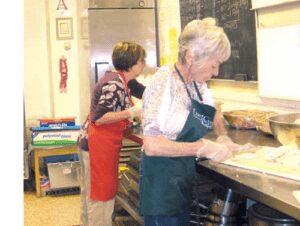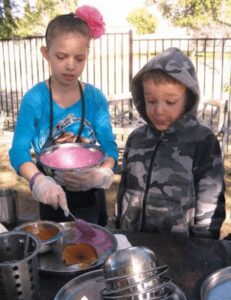Desert Garden Montessori School promotes good nutrition habits and healthy, happy students with an organic lunch program. From the April, 2014 issue of Tomorrow’s Child.
The End of the “Granola Crunchers”
Desert Garden Montessori School promotes good nutrition habits and healthy, happy students with an organic lunch program
by Margot Garfield-Anderson, The Montessori Foundation
Back in the late 1960s, I announced to my parents that I was becoming a vegetarian. In those days, we were referred to as “granola crunchers” because people didn’t really think about (or care about) good nutrition. With so many people finally becoming educated in this area, and wellness programs becoming increasingly the norm, we “granola crunchers” are no longer swimming against the tide.
With so many people finally becoming educated in this area, and wellness programs becoming increasingly the norm, we “granola crunchers” are no longer swimming against the tide.
Everywhere you look, natural, nongenetically modified and organic labels are popping up on the shelves of regular supermarket chains, convenience stores, and even chains such as WalMart and Target. We’ve created the demand and we’ve chipped away at the stereotype of the hippie in the Birkenstocks eating, yes, granola, and our time has come. (Confession: my vegetarianism lasted for 13 years before it came to an end, but vegetables still fill my plate at most meals.)
In January of this year, I had the privilege to visit Desert Garden Montessori School in Phoenix, Arizona for their International Montessori Council (IMC) onsite accreditation visit. (The IMC is the membership wing of The Montessori Foundation.) One of the reasons I was excited to be selected for this particular site visit was that the school has an organic lunch program.
The lunch program is an add-on to the cost of tuition, but it is broken down by cost per day, and it is really reasonable. Parents are assured that the child is eating a very well-balanced, high protein meal that is essential to proper brain nutrition, as well as one that is clean, tasty, and filling. This allows your children to have a meal that provides a slow carbohydrate burn that will sustain them for many hours. When compared to buying the ingredients of a lunch that contains such items as Snackables™, lunch meats, even peanut butter (almost all of which is loaded with sugar and salt along with stabilizers), white bread, cookies, and bags of fried chips, yes, the cost is more, but the value to the child just can’t compare. Many of these same items are on the Desert Garden ‘not-allowed-on-campus’ list, and that’s just the way it is.
The school has recently begun to plant edible gardens wherever space permits. The hope is that they can begin to offset some of the cost by growing their own organic produce, even if it’s just for snacking. The children see the vegetables, edible flowers, and herbs growing. They help tend the gardens and learn from the experience—and everyone gets to eat!
The school has three dedicated women in the kitchen working to create the menus, prep and cook the food, and help serve the lunches. The school has a wonderful outside area where they serve lunch. The students in the Elementary and Adolescent programs are very involved (after they earn their ‘food-handler card’); they set up, serve, clean up, and compost leftovers. What a learning process for these children.
I spent some time in the kitchen talking to Linda, Margot, and Mary about the menus and meal preparation. Menu items, such as chicken nuggets and grilled cheese sandwiches and mac and cheese are on the menu regularly. However, the ingredients are all organic and natural; the chicken nuggets are made from scratch and don’t contain chicken parts! Quinoa pasta is used for the mac part, and organic cheddar is used for the cheese.
Quinoa is actually not a grain; it’s a seed, and many people with gluten or grain restricted diets can eat quinoa. It is loaded with protein, comes in many varieties, and can be used instead of hot cereal for breakfast, as a great addition to a salad (along with some black beans and avocado), and as a side dish instead of white rice and pasta at dinner time. I’ve had quinoa burgers that were mixed with cashew butter instead of peanut butter and seasoned like any other burger, and they were awesome!
Another of the students’ favorites (and you may not believe this one but it’s true according to Linda) is broccoli. Yes, it’s worth repeating, broccoli! How in the world do you get kids to eat broccoli? The school has an Infant/Toddler program, and a large percentage of the student body has grown up in the school, which is now celebrating its 15th anniversary. The infants eat the exact same menu items as the rest of the school, so when it’s introduced over and over again, children’s taste buds create memories of these foods, and they begin to just think of it as something they’ve always eaten. (Of course, it might be blended for the littlest ones, but they are still receiving the nutritional benefit of eating these high-powered foods at this age as well.)
What happens with food the children just don’t like? Shetal, the head of school, has a rule that the children try a food three times before making the call to take it off the menu, which is supported by the create-taste-bud-memory theory just described. So, kudos to Desert Garden’s staff for sticking with this program and making sound nutrition as important a part of the day to children and staff as the rest of the rich Montessori curriculum.
 We are all becoming more aware of the benefits of good nutrition for children, pregnant woman, and adults of all ages. We have gathered a wealth of knowledge about how food works in the body, as well as how important it is to remove the processed, fat, and sugar-laden items from our diets. The use of natural or organic ingredients is finally making inroads into our vernacular, so that everyone can quickly identify better nutrition choices for themselves and their families.
We are all becoming more aware of the benefits of good nutrition for children, pregnant woman, and adults of all ages. We have gathered a wealth of knowledge about how food works in the body, as well as how important it is to remove the processed, fat, and sugar-laden items from our diets. The use of natural or organic ingredients is finally making inroads into our vernacular, so that everyone can quickly identify better nutrition choices for themselves and their families.
Schools that actually institute a nutrition program, such as Desert Garden, are still in the minority and we applaud their bravery. If more schools started programs such as this and more families chose these non-GMO, organic products, eventually, the cost of such items would continue to come down to meet the growing demand.
Back when my children were young, these kinds of foods were not readily available and the cost was off the charts. When I first became a vegetarian, I thought I could be a vegetarian by only eating vegetables and cheese. Green Giant™ broccoli in cheese
sauce was a staple of my diet. Hey, vegetables and cheese in one boilable pouch—easy, fast, and filling if you eat two or three bags at a sitting—and I was good to go. Do you know how many calories, grams of fat, sodium, and processed ingredients were in that cheese sauce? No wonder my weight ballooned! How could this be I pondered? I’m only eating vegetables. So when I returned to eating a non-vegetarian lifestyle I became a lot more aware and educated about good nutrition.
Foods such as legumes (canned beans packed with sugar and other additives don’t count), lentils, and garbanzo beans are all relatively inexpensive staples you can buy in most markets, and the preparation is usually simply to soak and sometimes boil for an hour. When you add these ingredients to stews and use them to replace white, processed rice or pasta, you are making a smart nutritional swap. In addition, you are filling your bellies with slow-burning, high-protein choices that keep you fuller for longer. When you choose to eat fried chip snacks or sugary treats, these foods don’t fuel your brain and are quickly in and out of your body, leaving you craving more and more of this type of food, so you eat more, it costs you more, and you have put nothing of value into your body.
Dr. Montessori was convinced that good fats such as real butter and good meats and soups, along with freshly baked, hearty bread (processed flour was not common in her time) all fed the child’s body and brain. She even advocated leaving the fat in meatballs.
The point is: You’ve already made the incredible commitment to provide a Montessori education for your child(ren), so why not make the commitment to go the full distance and provide a better source of fuel for your entire family? It’s really not hard. Just do it!
TOMORROW’S CHILD © ♦ APRIL 2014 ♦ WWW.MONTESSORI.ORG






